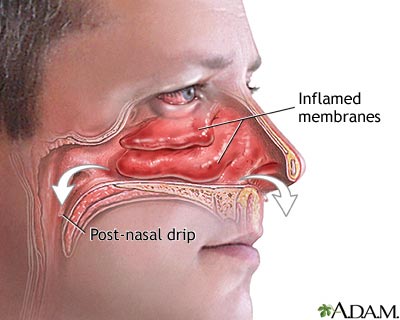Health Library
Stuffy or runny nose – adult
Nose - congested; Congested nose; Runny nose; Postnasal drip; Rhinorrhea; Nasal congestion
A stuffy or congested nose occurs when the tissues lining it become swollen. The swelling is due to inflamed blood vessels.
The problem may also include nasal discharge or "runny nose." If excess mucus runs down the back of your throat (postnasal drip), it may cause a cough or sore throat.
Images

I Would Like to Learn About:
Causes
A stuffy or runny nose may be caused by:
The congestion typically goes away by itself within a week.
Congestion also can be caused by:
- Hay fever or other allergies
- Use of some nasal sprays or drops bought without a prescription for more than 3 days (may make nasal stuffiness worse)
- Nasal polyps, sac-like growths of inflamed tissue lining the nose or sinuses
- Pregnancy
- Vasomotor rhinitis
Home Care
Finding ways to keep mucus thin will help it drain from your nose and sinuses and relieve your symptoms. Drinking plenty of clear fluids is one way to do this. You can also:
- Apply a warm, moist washcloth to your face several times a day.
- Inhale steam 2 to 4 times a day. One way to do this is to sit in the bathroom with the shower running. Do not inhale hot steam.
- Use a vaporizer or humidifier.
A nasal wash can help remove mucus from your nose.
- You can buy a saline spray at a drugstore or make one at home. To make one, use 1 cup (240 milliliters) of warm water, 1/2 teaspoon (3 grams) of salt, and a pinch of baking soda.
- Use gentle saline nasal sprays 3 to 4 times per day.
Congestion is often worse when lying down. Keep upright, or at least keep the head elevated.
Some stores sell adhesive strips that can be placed on the nose. These help widen the nostrils, making breathing easier.
Medicines you can buy at the store without a prescription can help your symptoms.
- Decongestants are drugs that shrink and dry up your nasal passages. They may help dry up a runny or stuffy nose.
- Antihistamines are drugs that treat allergy symptoms. Some antihistamines make you drowsy, so use with care.
- Nasal sprays can relieve stuffiness. Don't use over-the-counter nasal sprays more often than 3 days on and 3 days off, unless told to by your health care provider.
Many cough, allergy, and cold medicines you buy have more than one medicine inside. Read the labels carefully to make sure you don't take too much of any one medicine. Ask your provider which cold medicines are safe for you.
If you have allergies:
- Your provider may also prescribe nasal sprays that treat allergy symptoms.
- Learn how to avoid triggers that make allergies worse.
When to Contact a Medical Professional
Contact your provider for any of the following:
- A stuffy nose with swelling of the forehead, eyes, side of the nose, or cheek, or that occurs with blurred vision
- More throat pain, or white or yellow spots on the tonsils or other parts of the throat
- Discharge from the nose that has a bad smell, comes from only one side, or is a color other than white or yellow
- Cough that lasts longer than 10 days, or produces yellow-green or gray mucus
- Nasal discharge following a head injury
- Symptoms that last more than 3 weeks
- Nasal discharge with fever
What to Expect at Your Office Visit
Your provider may perform a physical exam that focuses on the ears, nose, throat, and airways.
Tests that may be done include:
- Allergy skin tests
- Blood tests
- Sputum culture and throat culture
- X-rays of the sinuses and chest x-ray
Related Information
Obstructive sleep apnea - adultsEnlarged adenoids
References
Bachert C, Zhang N, Gevaert P. Rhinosinusitis and nasal polyps. In: Burks AW, Holgate ST, O'Hehir RE, et al, eds. Middleton's Allergy: Principles and Practice. 9th ed. Philadelphia, PA: Elsevier; 2020:chap 41.
Corren J, Baroody FM, Togias A. Allergic and nonallergic rhinitis. In: Burks AW, Holgate ST, O'Hehir RE, et al, eds. Middleton's Allergy: Principles and Practice. 9th ed. Philadelphia, PA: Elsevier; 2020:chap 40.
Cohen YZ. The common cold. In: Bennett JE, Dolin R, Blaser MJ, eds. Mandell, Douglas, and Bennett's Principles and Practice of Infectious Diseases. 9th ed. Philadelphia, PA: Elsevier; 2020:chap 58.
BACK TO TOPReview Date: 7/19/2021
Reviewed By: Linda J. Vorvick, MD, Clinical Associate Professor, Department of Family Medicine, UW Medicine, School of Medicine, University of Washington, Seattle, WA. Also reviewed by David Zieve, MD, MHA, Medical Director, Brenda Conaway, Editorial Director, and the A.D.A.M. Editorial team.
 | A.D.A.M., Inc. is accredited by URAC, for Health Content Provider (www.urac.org). URAC's accreditation program is an independent audit to verify that A.D.A.M. follows rigorous standards of quality and accountability. A.D.A.M. is among the first to achieve this important distinction for online health information and services. Learn more about A.D.A.M.'s editorial policy, editorial process and privacy policy. A.D.A.M. is also a founding member of Hi-Ethics. This site complies with the HONcode standard for trustworthy health information: verify here. |
The information provided herein should not be used during any medical emergency or for the diagnosis or treatment of any medical condition. A licensed medical professional should be consulted for diagnosis and treatment of any and all medical conditions. Links to other sites are provided for information only -- they do not constitute endorsements of those other sites. © 1997- 2023 A.D.A.M., a business unit of Ebix, Inc. Any duplication or distribution of the information contained herein is strictly prohibited.
